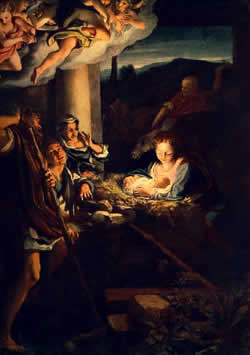
Correggio's Nativity turns traditional solemn stiffness into a sensual event. The antithetical light-dark technique (chiaroscuro) with its very delicate colour scheme and tinted shadows achieves the effect of a veil of light (sfumato). The light appears simultaneously to bathe and to emerge from the Child, who is lying on a rough pallet, only to soften on the face of Mary, tenderly rapt in a maternal embrace. This intimate closeness of mother and Child is typical of the Baroque. Tension is created by the painting's two halves marked by a diagonal line, joined together by the the manger that is placed at the centre: a calm and contemplative half with the Holy Family, and emotional struggles in the half with the deeply moved shepherds and midwife standing back in awe, and whose fluid gestures are mirrored by those of the cherubim on the cloud that spreads hazily through the picture. Joseph, as usual, stands apart or in the background. In the manner of Renaissance syncretism, the shepherds strike the pose of the Laocoon group which had been discovered some twenty years earlier.